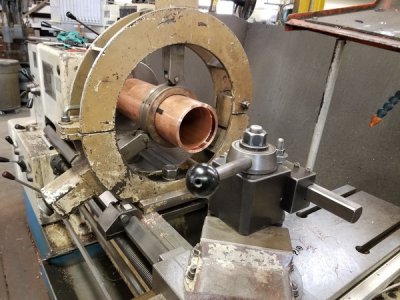Most steel tube and pipe is produced from rolled flat stock which is notorious for its poor machining qualities yet excellent formability.
The faster you turn it the better the results will be, if the machine is capable I would turn such a small part in that material at 3000 RPM's minimum at .006-.008 IPM feed using a negative insert with a smallish sub .015 nose radius as a start and go from there, the first few may be scrap but it appears to be a common material which is cheap so have at it.
I often make electrical conductors from Customer Supplied Material, If a mistake is made one can not simply saw off another piece of stock and start again, they supply just enough.
Like so, 6 5/8" copper pipe 19 3/4" long with a 3/4" deep counterbore on each end at 5.875" +.002 -0.000 diameter, I only get one try.
View attachment 253089

